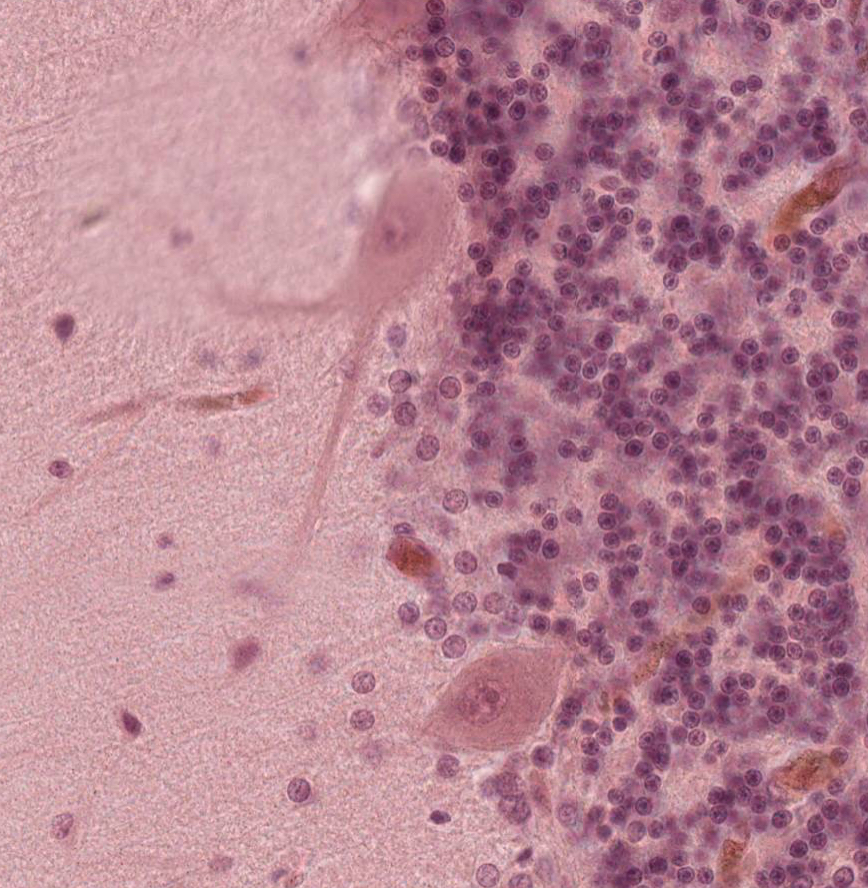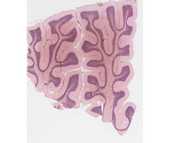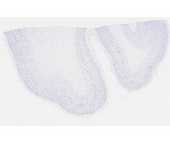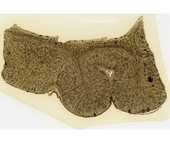Brain
#86 Cerebellum, H&E
Observe the pale staining branches of the central white matter surrounded by a darkly stained cortex. Identify the outer, pale-staining molecular layer of the cerebellar cortex, and the inner, basophilic granular layer of the cortex. Both the molecular layer and granular layer constitute the gray matter. The molecular layer contains axons and dendrites, but relatively few neurons compared to the granular layer.
On these sections of the cerebellum, the cut surfaces may result in the exposure of the pale-staining medulla (white matter) at the surface of the section, where it could be confused with the molecular layer of the cortex. Try to find a surface covered by the meninges, to insure that you are indeed looking at the cortical surface.
 With medium power magnification, examine the junctional zone between the molecular and granular layers of the cortex. Note the large, flask- shaped cells aligned in a row; these are the cell bodies of Purkinje cells.
With medium power magnification, examine the junctional zone between the molecular and granular layers of the cortex. Note the large, flask- shaped cells aligned in a row; these are the cell bodies of Purkinje cells.
The basophilic nuclei of the granular layer, which superficially resemble lymphocyte nuclei, belong to granule cells. Axons of these cells (not visible with H&E) extend into the molecular layer and relay neural information to this layer.
#108 Cerebral Cortex, Nissl
 At low magnification find the gray matter (cerebral cortex) and white matter, which in this stain can be identified by the rows of small oligodendrocyte and astrocyte nuclei between the unstained axons and their myelin sheaths. The cortex, itself, is divided into 6 layers, not all of which are clearly distinguishable in this slide. Do not try to find all of them. At higher power study the large pyramidal cells, which are prominent in deeper parts of the cortex. Study the nucleus, nucleolus, and Nissl substance. Note the similarity of the large pyramidal cells to the large motor neurons in the ventral horn of the spinal cord.
At low magnification find the gray matter (cerebral cortex) and white matter, which in this stain can be identified by the rows of small oligodendrocyte and astrocyte nuclei between the unstained axons and their myelin sheaths. The cortex, itself, is divided into 6 layers, not all of which are clearly distinguishable in this slide. Do not try to find all of them. At higher power study the large pyramidal cells, which are prominent in deeper parts of the cortex. Study the nucleus, nucleolus, and Nissl substance. Note the similarity of the large pyramidal cells to the large motor neurons in the ventral horn of the spinal cord.
#111 Cerebral Cortex, Golgi, 100µm, Celloidin embedded
 The Golgi procedure results in 1-2% of neurons impregnated with heavy metals. No one is sure why not all cells are stained. Please note this preparation shows the detailed architecture of individual neurons. The thickness of the sections allows one to appreciate the space occupied by a neuron's dendritic tree.
The Golgi procedure results in 1-2% of neurons impregnated with heavy metals. No one is sure why not all cells are stained. Please note this preparation shows the detailed architecture of individual neurons. The thickness of the sections allows one to appreciate the space occupied by a neuron's dendritic tree.


